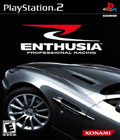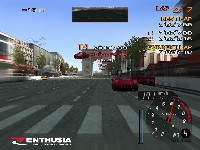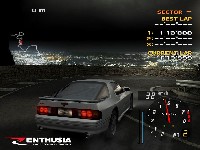Genre: Driving
Publisher: Konami
Developer: Konami Studio 3
Release Date: May 3, 2005
The auto racing "sim" business has been brewing, and in March 2005, Konami will offer its much-touted Enthusia Professional Racing for your driving pleasure. Truly in the nature of a simulation, Konami’s Studio 3 intended to create the best driving simulator ever made, right from the start. All the way back to last summer, Konami has been very proud of the progress in game development of Enthusia, including the number of cars, proprietary physics engine, and graphical representation of inertial forces and traction.
More recently, Konami has promoted the integration of information into the cars of Enthusia, beyond simple measurements like wheelbase. Hundreds of measurements, like the suspension's travel in response to pressure, have been integrated into each vehicle's movement, making them respond as realistically as possible.
In making Enthusia, Konami ran these tests on over 200 cars and incorporated each in to the game. These cars come from over 50 manufacturers, and Konami can practically dare you to name every one – good luck, as we were unable to guess them all – would you think of a Mitsubishi minivan? Essentially, the basics of Enthusia Professional Racing come down to 200 cars, 50 car makers, and 50 tracks on which to race the cars. Where are the tracks? Take it easy on that gas pedal, we’re getting to it…
The tracks of Enthusia are many, but many are not reality. Konami only chose to incorporate two real tracks into the title, and as a "simulator" of the real racing experience, this may be a major challenge. With only two of 50 courses existing in reality, this equates to only 4% of courses created to match what professional drivers experience. The other 48 courses may be created with the driver in mind, but if Enthusia is attempting to be a racing simulation, how realistic is it with 96% of the tracks created to fit Konami's needs? To date, we can't answer this question completely.
As exposure to Enthusia has increased in the coming months, we've gotten to experience many of the tracks, and it seems the original track designs are geared toward highlighting the potential of a given car on a given track. This emphasizes the need for a driver to be skilled in driving several cars, rather than just picking one machine to win it all. For some of the courses, a light machine with nimble cornering will swerve its way to the checkered flag, while another track will capitalize on the brute muscle of acceleration into the straightaways. Still another valuable asset is the machine with the aerodynamics and balanced power for stable handling in the corners and high top-speed in the long runs in-between. One word sums it up: balance. Enthusia creates an environment where the reality of each machine is promoted – or punished – by its attributes in interaction with the course.
On qualification for "sim" status, this is very good for Enthusia. Hearkening to an end of the days where a player can pick a Honda Civic, trick it out, and bounce off barriers to win the race, Enthusia may be packaged as a simulation of a real driving experience, but it still has an arcade feel. So where does Enthusia fall in its endeavor to be the best driving simulator ever? It remains to be seen. The most realistic does not necessarily mean the "best" to some people, and it seems that Konami is well tuned to this.
But what about Konami's new fancy gadgets and gizmos? Isn’t there some new innovation called a Visual Gravity System? What about that "G-ball" thing?
Okay, let’s take a look at the Visual Gravity System and the "G-ball." As you will see in the screenshots, Enthusia has created an environment where you not only see vehicles lurch in response to inertia, but you also have a visual representation of the centripetal force acting on your vehicle as you try to turn corners at the highest speed possible. The easiest part of the display to interpret is the shift in your vehicle's center of gravity. As you turn corners, decelerate and accelerate, the ball shifts to show which wheels are getting more traction, and just how close you are to skidding out of control. Another major impetus behind Konami's development of the Visual Gravity System was to increase your perception of speed and motion in the game, with the visual representation of inertia in the game reminding you of real-life driving experiences.
Outside of providing a neat animation during gameplay, we weren’t really sure how useful this new Visual Gravity System was going to be – until we saw the traction display element of the new system. Your vehicle's tires comprise the extremities of the new display, and they change colors depending on the amount of traction the given tire has. More traction makes the tire display turn white, and slippage of the tires causes the display to turn red. Again, this visual representation of the frictional coefficient each car possesses is intended to strengthen the link between you and the machine, increasing your sensation of speed.
In the end, these visual representations of the physical forces acting upon the car may provide a greater sensation of speed, but it will be of far greater use as a technical interface to the game for the player. The use of a visual system for conveying the most useful information in relation to the handling of the vehicle will provide instant feedback for the driver, and once interpretation of this information becomes second nature for the player, response to changing forces will not only become more simplified and efficient, but also uncannily accurate.
There is one major feature available in Enthusia that will also aid players in their quest to drive as natural and skillful as any professional driver. Enthusia has borrowed a bit from Konami's popular Dance Dance Revolution titles. Confused? That's okay – we were too.
Enthusia calls it Driving Revolution, where a series of rings are placed on the track, and it is up to the driver to drive through them as accurately as possible. Enthusia counts the number of perfect hits, just like DDR, but there is one more important aspect to this mode. Enthusia places these rings on the track in the optimal position for peak performance on the track, and even conveys the optimal speed of the vehicle, telling the player to speed up or slow down. While this may just seem like a cool mode to play Enthusia in, it may possibly become the best driving tutorial we've experienced in recent memory. From this point forward, we expect to hear a great deal more about the Driving Revolution feature, as it is the most striking innovation Enthusia presents to date.
The Driving Revolution mode, combined with the Visual Gravity System, promise that Enthusia will bring some innovation and development to racing simulators on all platforms. Will it be the best driving simulator ever? There's still a lot to be worked out, as the invisible barriers on some corner's infields prove, but Enthusia should easily shape up to be a heavyweight contender in its field. While you’re waiting for a review, we’re going to get a shot at some of the 191 cars we haven't played yet, and see if Konami's custom tracks are really worth foregoing the real loops of pavement all over planet Earth.
More articles about Enthusia Professional Racing
















































